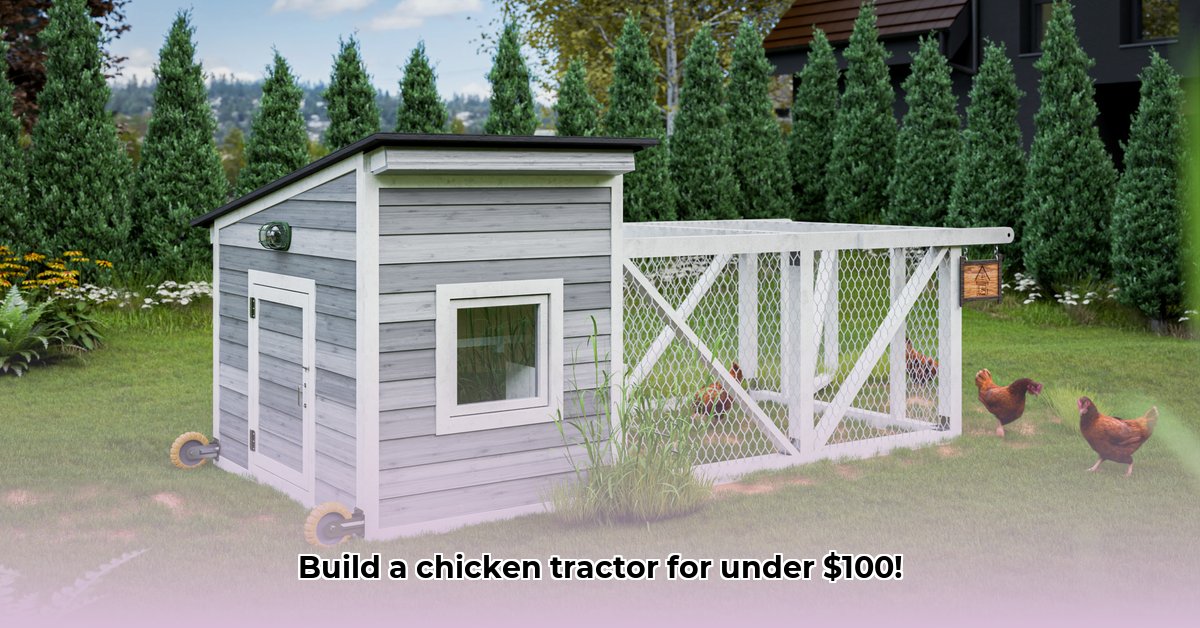
Want fresh, farm-fresh eggs and happy, healthy hens? Building a chicken tractor might be the perfect solution! This comprehensive guide will walk you through designing, building, and maintaining a chicken tractor ideal for 10 hens. We'll also compare chicken tractors with traditional stationary coops, helping you make the best choice for your needs and lifestyle. For more detailed plans, check out these chicken tractor plans.
Why Choose a Chicken Tractor?
A chicken tractor isn't just a coop; it's a mobile paradise for your flock! Imagine a self-moving chicken buffet, providing fresh pasture daily. This dynamic setup offers numerous advantages:
Healthier Hens: Constant access to fresh grass, bugs, and greens enriches their diet and reduces stress, leading to healthier, happier chickens. Think of it as a natural vitamin supplement!
Disease Prevention: The mobility prevents parasite build-up and disease transmission, common in stationary coops where droppings accumulate. Moving the tractor regularly minimizes contamination.
Natural Pest Control: Your hens become your garden's allies, consuming slugs, grubs, and other pests, benefiting your lawn and garden. It's a win-win!
Improved Predator Protection: A stationary coop is a static target for predators. A movable chicken tractor makes it significantly harder for foxes, raccoons, or other predators to locate and attack your flock.
Simplified Cleaning: Cleaning a chicken tractor is much easier than cleaning a traditional coop. The smaller space makes cleaning and bedding replacement quick and efficient.
Stationary Coops vs. Chicken Tractors: A Detailed Comparison
Choosing between a stationary coop and a chicken tractor involves weighing several factors. Here's a comparative analysis to guide your decision:
| Feature | Stationary Coop | Chicken Tractor |
|---|---|---|
| Upfront Cost | Higher; more materials and potential labor costs | Lower; simpler design and fewer materials needed |
| Maintenance | Higher; more frequent cleaning and repairs | Lower; easier and faster cleaning, but daily relocation |
| Pasture Impact | Can lead to overgrazing and soil compaction | Promotes healthy pasture rotation; minimal lawn damage |
| Predator Protection | Generally higher; easier to secure | Lower; mobility is a deterrent but requires extra security |
| Space Efficiency | Requires a dedicated, larger area | More space-efficient; can utilize various areas |
| Mobility | Stationary; no relocation option | Easily moved daily or as needed |
Building Your Chicken Tractor: A Step-by-Step Guide
Building a chicken tractor is a rewarding DIY project. Follow these steps to create a safe and comfortable home for your 10 hens:
Step 1: Planning and Design: Sketch your tractor's dimensions. Aim for 4 square feet per hen (40 sq ft total) to ensure comfortable living space. Consider using pressure-treated lumber for durability.
Step 2: Gathering Supplies: You'll need lumber, sturdy wire mesh (hardware cloth), hinges, a secure latch, roofing material (metal is recommended), wheels or runners, screws, nails, and other fasteners.
Step 3: Constructing the Frame: Build a strong rectangular frame using your lumber, ensuring stability and square corners. The frame must support the weight of your hens and withstand weather conditions.
Step 4: Adding Walls and Roof: Attach the wire mesh to the frame, creating the walls. This protects your chickens while allowing ventilation. Install a secure roof to shield them from sun and rain.
Step 5: Installing the Door and Wheels: Build a secure door with a tight-fitting latch. Attach sturdy wheels or runners, ensuring smooth movement across your yard. A ramp can facilitate chicken access.
Step 6: Final Touches: Add roosting bars (simple branches or store-bought perches) and nesting boxes (repurposed containers work well).
Potential Challenges and Solutions
Even with careful planning, challenges can arise. Here are some potential issues and how to address them:
Weatherproofing: Use durable roofing materials (metal roofing is excellent). Consider adding a tarp or windbreak for extra protection.
Winterizing: In cold climates, additional insulation or supplemental heating (heat lamps used cautiously) might be needed.
Predator Protection: While mobility is a deterrent, reinforce the bottom with hardware cloth to prevent digging predators.
Is a Chicken Tractor Right for You?
A chicken tractor offers numerous benefits, but it's not for everyone. Consider these factors:
Ease of Maintenance: Chicken tractors require daily relocation. This adds to the labor but simplifies cleaning.
Pasture Management: Rotational grazing is key; this improves pasture health but necessitates planning.
Predator Risk: Mobility offers some protection, but additional security measures are often necessary.
Weigh these factors against the benefits to decide if a chicken tractor aligns with your lifestyle and resources.
Key Takeaways: Choosing the Right Coop Type
The optimal coop type depends on various factors including farm size, predator prevalence, labor availability, and desired pasture management practices.
Mobile coops promote pasture rotation, but increase daily maintenance needs and have lower predator protection.
Stationary coops demand less labor, provide enhanced predator protection, but can lead to pasture degradation.
A hybrid approach, combining free-ranging with a stationary coop can improve both pasture health and predator safety.